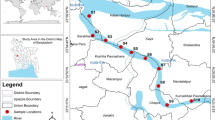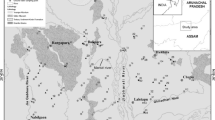Abstract
The primary intention of the current work was to appreciate the hydrochemistry characteristics and the water quality of the Euphrates river basin in Turkey. The water quality index technique (WQI) was adopted here for drinking criterion, while the United State salinity diagram and Wilcox’s diagram were constructed to assure the river expediency for irrigation standards. Factor analysis (FA) and cluster analysis (CA) were harnessed for identifying the paramount factors influencing the water quality and estimating the spatial variations amongst the sampling sites. It has been demonstrated that water–rock interactions have a pivotal influence on the river basin. It has been inferred from the Piper plot that water in the Euphrates basin is of Mg–HCO3 type. Alkaline earth metals and weak acids were prevalent rather than alkalis and strong acids. Besides that, silicate weathering is the dominant process within the river basin. Virtually, the majority of samples have met the drinking and irrigation standards. FA has revealed four factors that contributed to 71.453% of the total discrepancy in water quality while two disparate groups of similarities were uncovered between the sampling sites, reflecting palpable pollution levels within the river basin.








Similar content being viewed by others
References
Abdalla FA, Scheytt T (2012) Hydrochemistry of surface water and groundwater from a fractured carbonate aquifer in the Helwan area. Egypt J Earth Syst Sci 121:109–124. https://doi.org/10.1007/s12040-012-0140-7
Akbaş Z (2015) Turkey’s euphrates and security issues and conflict risks resulting from transboundary waters of the Tigris. J Soc Sci Turk World 72:93–116 (in Turkish)
Akter S, Ahmed KR (2019) Water chemistry and water quality of a tidal river system in relation with riverbank land use pattern and regional climate in the southwest Bengal Delta of Bangladesh. Sustain Water Resour Manag 5:1259–1279. https://doi.org/10.1007/s40899-019-00308-3
Al-Bomola A (2011) Temporal and spatial changes in water quality of the Euphrates River Iraq. MSc Thesis, University of Lund, Lund Sweden.
Al-Marsoumi AH, Al-Bayati KM, Al-Mallah EA (2006) Hydrogeochemical aspects of tigris and Euphrates rivers within Iraq: a comparative study. Rafidin J Sci 17(2):34–49
Alp MT, Kocer M, Sen B, Ozbay O (2010) Water quality of surface waters in Lover Euphrates Basin (Southeastern Anatolia, Turkey. J Anim Vet Adv 9(18):2412–2421
Altın A, Filiz Z, Iscen CF (2009) Assessment of seasonal variations of surface water quality characteristics for Porsuk Stream. Environ Monit Assess 158:51–65
Altınbilek D (2004) Development and management of the Euphrates–Tigris basin. Int J Water Resour D 20:15–33
Arslan-Alaton I, Eremektar G, Ongan Torunoglu P, Gürel M, Övez S, Tanik A, Orhon D (2005) Water-wastewater resources based on river basins in Turkey and urban wastewater treatment potential. ITU J 4(3):13–23
Asare-Donkor NK, Ofosu JO, Adimado AA (2018) Hydrochemical characteristics of surface water and ecological risk assessment of sediments from settlements within the Birim River basin in Ghana. Environ Syst Res. https://doi.org/10.1186/s40068-018-0113-1
Awadh SM, Ahmed RM (2013) Hydrochemistry and pollution probability of selected sites along the Euphrates River, Western Iraq. Arab J Geosci 6:2501–2518. https://doi.org/10.1007/s12517-012-0538-1
Beaumont P (1998) Restructuring of water usage in the Tigris-Euphrates basin: the impact of modern water management policies. In: Albert J, Bernhardsson M, Kenna R (eds) Transformations of middle eastern natural environments: legacies and lessons, bulletin series no. 103. Yale School of Forestry and Environmental Studies, New Haven, pp 168–186
Bilgen A (2020) Turkey’s Southeastern Anatolia Project (GAP): a qualitative review of the literature. Br J Middle East Stud 47(4):652–671
Bilgin A (2018) Evaluation of surface water quality by using Canadian Council of Ministers of the Environment Water Quality Index (CCME WQI) method and discriminant analysis method: a case study Coruh River Basin. Environ Monit Assess 190:554
Boyacioglu H, Boyacioglu H (2007) Surface Water Quality Assessment by environmetric methods. Environ Monit Assess 131:371–376
Bozkurt D (2013) Climate change impacts on the hydrology of The Euphrates–Tigris basin. Istanbul Technical University-Eurasia Institute Of Earth Sciences. Ph.D.Thesis, Istanbul, p 126
Das N, Patel AK, Deka G, Das A, Sarma KP, Kumar M (2015) Geochemical controls and future perspective of arsenic mobilization for sustainable groundwater management: a study from Northeast India. Groundw Sustain Dev 1:92–104
Das N, Sarma KP, Patel AK, Deka JP, Das A, Kumar A, Shea PJ, Kumar M (2017) Seasonal disparity in the co-occurrence of arsenic and fluoride in the aquifers of the Brahmaputra flood plains, Northeast India. Environ Earth Sci 76:183. https://doi.org/10.1007/s12665-017-6488-x
Değirmenci S (2007) Turkey’s transboundary waters and water problem in middle east within the context of Firat, Dicle, Asi Rivers. Pamukkale University Graduate School of Social Sciences, MSc Thesis.
Donohue I, Style D, Coxon C, Irvine K (2006) Importance of spatial and temporal patterns for assessment of risk of diffuse nutrient emissions to surface waters. J Hydrol (Amsterdam) 304:183–192
Elhatip H, Hinis MA (2014) Statistical approaches for estimating the environmental flows in a river basin: case study from the Euphrates River catchment, Eastern Anatolian part of Turkey. Environ Earth Sci 73:4633–4646
Garzanti E, Al-Juboury AI, Zoleikhaei Y, Vermeesch P, Jotheri J, Akkoca DB, Obaid AK, Allen MB, Andó S, Limonta M, Padoan M, Resentini A, Rittner M, Vezzoli G (2016) The Euphrates–Tigris–Karun river system: provenance, recycling and dispersal of quartz-poor foreland-basin sediments in arid climate. Earth Sci Rev 162:107–128
Gibbs RJ (1970) Mechanisms controlling world’s water chemistry, volt. Science 170:1088–1090
İşçen CF, Altın A, Şenoğlu B, Yavuz HS (2009) Evaluation of surface water quality characteristics by using multivariate statistical techniques: a case study of the Euphrates river basin, Turkey. Environ Monit Assess 151:259–264
Ismail AH, Muntasir AH (2018) Estimation of river Tigris dispersivities using a steady-state numerical model. Appl Water Sci 8:108
Ismail AH, Robescu D (2019a) Application of multivariate statistical techniques in water quality assessment of Danube river, Romania. Environ Eng Manag J 18(3):719–726
Ismail AH, Robescu D (2019b) Assessment of water quality of the Danube river using water quality indices technique. Environ Eng Manag J 18(8):1727–1737
Ismail AH, Abed BS, Abdul-Qader S (2014) Application of multivariate statistical techniques in the surface water quality assessment of Tigris river at Baghdad stretch. J Babylon Univ 22(2):450–462
Ismail AH, Muntasir AH, Channo RJ (2015) Groundwater Quality Assessment in urban area of Baghdad, Iraq, using multivariate statistical techniques. Eng Technol J 33(2):463–476
Ismail AH, Muntasir AS, Mahmood M (2018) Hydrochemical characterization of groundwater in Balad district, Salah Al-Din Governorate, Iraq. J Groundw Sci Eng 6(4):306–322
Ismail AH, Shareef MA, Alatar FM (2019) Hydrochemistry of groundwater and its suitability for drinking and irrigation in Baghdad, Iraq. Environ Process 6:543–560
Ismail AH, Hassan G, Sarhan AH (2020) Hydrochemistry of shallow groundwater and its assessment for drinking and irrigation purposes in Tarmiah district, Baghdad governorate, Iraq. Groundw Sustain Dev 10:100300. https://doi.org/10.1016/j.gsd.2019.100300
Marghade D, Malpe DB, Zade AB (2012) Major ion chemistry of shallow groundwater of a fast growing city of Central India. Environ Monit Assess 184(4):2405–2418
Nair HC, Joseph A, Gopinathan VP (2020) Hydrochemistry of tropical springs using multivariate statistical analysis in Ithikkara and Kallada river basins, Kerala, India. Sustain Water Resour Manag 6:9. https://doi.org/10.1007/s40899-020-00363-1
Nganje TN, Hursthouse AS, Edet A et al (2017) Hydrochemistry of surface water and groundwater in the shale bedrock, Cross River Basin and Niger Delta Region, Nigeria. Appl Water Sci 7:961–985. https://doi.org/10.1007/s13201-015-0308-9
Odemis B, Evrendilek F (2008) Multivariate analysis of watershed health and sustainability in Turkey. Int J Sust Dev World 15(3):265–272
Ozdogan M (2011) Climate change impacts on snow water availability in the Euphrates–Tigris basin. Hydrol Earth Syst Sci 8:3631–3666
Öziş Ü, Özdemir Y (2008) Euphrates–Tigris rivers basin and Turkey. TMMOB 2. Water Policy Congress.
Palma P, Alvarenga P, Palma VL, Fernandes RM, Soares AMVM, Barbosa IR (2010) Assessment of anthropogenic sources of water pollution using multivariate statistical techniques: a case study of the Alqueva’s reservoir, Portugal. Environ Monit Assess 165:539–552
Piper AM (1944) A graphical procedure in the geochemical interpretation of water. Trans Am Geophys Union 25:914–928
Poletaeva VI, Pastukhov MV, Zagorulko NA et al (2018) Changes in water hydrochemistry in Bays of the Bratsk Reservoir Caused by forest harvesting operations. Water Resour 45:369–378. https://doi.org/10.1134/S0097807818030119
Rahi KA, Halihan T (2010) Changes in the salinity of the Euphrates River system in Iraq. Reg Environ Change 10(1):27–35
Sen OL, Unal A, Bozkurt D, Kindap T (2011) Temporal changes in the Euphrates and Tigris discharges and teleconnections. Environ Res Lett. https://doi.org/10.1088/1748-9326/6/2/024012
Shrestha S, Kazama F (2007) Assessment of surface water quality using multivariate statistical techniques: a case study of the Fuji river basin, Japan. Environ Modell Softw 22:464–475
Simeonov V, Simeonova P, Tsitouridou R (2004) Chemometric quality assessment of surface water: two case studies. Chem Eng Ecol 11:449–469
Singh N, Singh RP, Kamal V, Sen R, Mukherjee S (2015) Assessment of hydrogeochemistry and the quality of groundwater in 24-Parganas districts, West Bengal. Environ Earth Sci 73:375–386
Tosun H, Zorluer I, Orhan A, Seyrek E, Savas H, Turkoz M (2007) Seismic hazard and total risk analyses for large dams in Euphrates Basin, Turkey. Eng Geol 89:155–170
Umar R, Alam F (2012) Assessment of hydrogeochemical characteristics of groundwater in parts of Hindon-Yamuna interfluve region, Baghpat District, Western Uttar Pradesh. Environ Monit Assess 184:2321–2336
UN United Nations (2013) İnventory of shared water resources in Western Asia. United Nations Economic and Social Commission for Western Asia, New York
UN WWAP (2003) United Nations World Water Assessment Programme. The World water development report 1: water for people, water for life. UNESCO, Paris
Unver IHO (1997) Southeastern Anatolia Project (GAP). Water Resour Dev 13(4):453–483
USSL (US Salinity Laboratory) (1954) Diagnosis and improvement of salinity and alkaline soil. USDA hand book no. 60. USSL, Washington
Varol M, Sen B (2009) Assessment of surface water quality using multivariate statistical techniques: a case study of Behrimaz Stream, Turkey. Environ Monit Assess 159:543–553
Wang H, Li X, Xie Y (2011) Hydrochemical evaluation of surface water quality and pollution source apportionment in the Luan River basin, China. Water Sci Technol 64(10):2119–2125
WHO (2011) Guidelines for drinking-water quality, vol 216. World Health Organization, pp 303–304
Wilcox LV (1955) Classification and use of irrigation waters. USDA, Washington, p 969
Yigit Y, Cakmak B (2018) Evaluation of water use for agriculture in Fırat Basin irrigation schemes. SDU J Fac Agric 13(1):103–108
Zaman S, Ye M, Zhang F et al (2018) Correction to: multivariate statistical and trend analyses of surface water quality in the central Indian River Lagoon area, Florida. Environ Earth Sci 77:185. https://doi.org/10.1007/s12665-018-7380-z
Zhou F, Liu Y, Guo H (2007) Application of multivariate statistical methods to water quality assessment of the watercourses in Northwestern New Territories, Hong Kong. Environ Monit Assess 132:1–13
Zowain A, Ismail AH (2015) Management of salinity issues in Iraq’s agricultural sector using SWOT analysis. Eng Technol J 33(3):644–658
Author information
Authors and Affiliations
Corresponding author
Ethics declarations
Conflict of interest
The authors declare that they have no conflict of interest.
Additional information
Publisher's Note
Springer Nature remains neutral with regard to jurisdictional claims in published maps and institutional affiliations.
Rights and permissions
About this article
Cite this article
Yürekli, K., Erdoğan, M., Ismail, A.H. et al. How far can hydrochemical characteristics of surface water meet drinking and irrigation criteria: a pragmatic study for the Euphrates river basin, Turkey. Sustain. Water Resour. Manag. 7, 25 (2021). https://doi.org/10.1007/s40899-021-00507-x
Received:
Accepted:
Published:
DOI: https://doi.org/10.1007/s40899-021-00507-x




